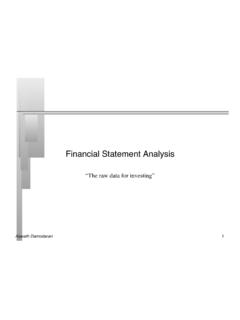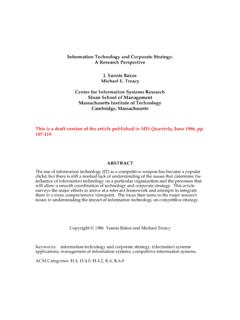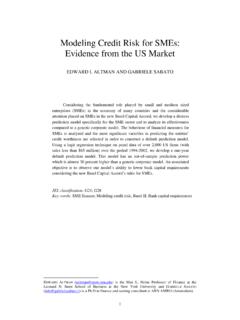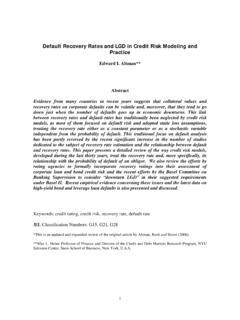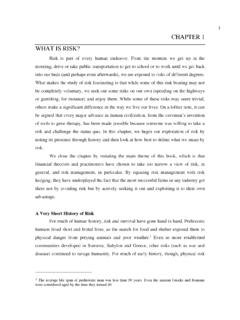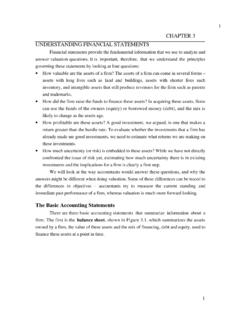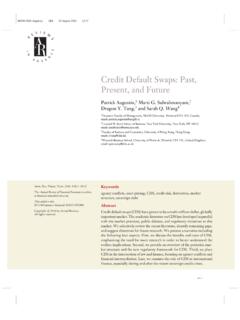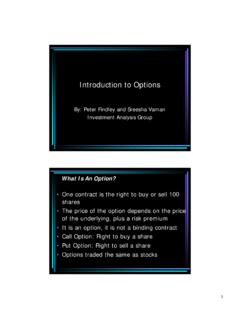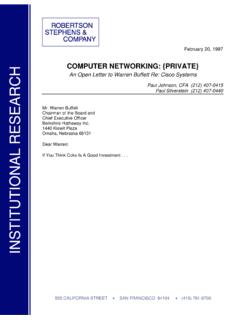Transcription of VALUE AT RISK (VAR)
1 1 VALUE AT RISK (VAR) What is the most I can lose on this investment? This is a question that almost every investor who has invested or is considering investing in a risky asset asks at some point in time. VALUE at Risk tries to provide an answer, at least within a reasonable bound. In fact, it is misleading to consider VALUE at Risk, or VaR as it is widely known, to be an alternative to risk adjusted VALUE and probabilistic approaches. After all, it borrows liberally from both. However, the wide use of VaR as a tool for risk assessment, especially in financial service firms, and the extensive literature that has developed around it, push us to dedicate this chapter to its examination. We begin the chapter with a general description of VaR and the view of risk that underlies its measurement, and examine the history of its development and applications. We then consider the various estimation issues and questions that have come up in the context of measuring VAR and how analysts and researchers have tried to deal with them.
2 Next, we evaluate variations that have been developed on the common measure , in some cases to deal with different types of risk and in other cases, as a response to the limitations of VaR. In the final section, we evaluate how VaR fits into and contrasts with the other risk assessment measures we developed in the last two chapters. What is VALUE at Risk? In its most general form, the VALUE at Risk measures the potential loss in VALUE of a risky asset or portfolio over a defined period for a given confidence interval. Thus, if the VaR on an asset is $ 100 million at a one-week, 95% confidence level, there is a only a 5% chance that the VALUE of the asset will drop more than $ 100 million over any given week. In its adapted form, the measure is sometimes defined more narrowly as the possible loss in VALUE from normal market risk as opposed to all risk, requiring that we draw distinctions between normal and abnormal risk as well as between market and non-market risk.
3 While VALUE at Risk can be used by any entity to measure its risk exposure, it is used most often by commercial and investment banks to capture the potential loss in VALUE of their traded portfolios from adverse market movements over a specified period; 2 this can then be compared to their available capital and cash reserves to ensure that the losses can be covered without putting the firms at risk. Taking a closer look at VALUE at Risk, there are clearly key aspects that mirror our discussion of simulations in the last chapter: 1. To estimate the probability of the loss, with a confidence interval, we need to define the probability distributions of individual risks , the correlation across these risks and the effect of such risks on VALUE . In fact, simulations are widely used to measure the VaR for asset portfolio. 2. The focus in VaR is clearly on downside risk and potential losses. Its use in banks reflects their fear of a liquidity crisis, where a low-probability catastrophic occurrence creates a loss that wipes out the capital and creates a client exodus.
4 The demise of Long Term capital Management, the investment fund with top pedigree Wall Street traders and Nobel Prize winners, was a trigger in the widespread acceptance of VaR. 3. There are three key elements of VaR a specified level of loss in VALUE , a fixed time period over which risk is assessed and a confidence interval. The VaR can be specified for an individual asset, a portfolio of assets or for an entire firm. 4. While the VaR at investment banks is specified in terms of market risks interest rate changes, equity market volatility and economic growth there is no reason why the risks cannot be defined more broadly or narrowly in specific contexts. Thus, we could compute the VaR for a large investment project for a firm in terms of competitive and firm-specific risks and the VaR for a gold mining company in terms of gold price risk. In the sections that follow, we will begin by looking at the history of the development of this measure , ways in which the VaR can be computed, limitations of and variations on the basic measures and how VaR fits into the broader spectrum of risk assessment approaches.
5 A Short History of VaR While the term VALUE at Risk was not widely used prior to the mid 1990s, the origins of the measure lie further back in time. The mathematics that underlie VaR were largely developed in the context of portfolio theory by Harry Markowitz and others, 3 though their efforts were directed towards a different end devising optimal portfolios for equity investors. In particular, the focus on market risks and the effects of the co-movements in these risks are central to how VaR is computed. The impetus for the use of VaR measures, though, came from the crises that beset financial service firms over time and the regulatory responses to these crises. The first regulatory capital requirements for banks were enacted in the aftermath of the Great Depression and the bank failures of the era, when the Securities Exchange Act established the Securities Exchange Commission (SEC) and required banks to keep their borrowings below 2000% of their equity capital .
6 In the decades thereafter, banks devised risk measures and control devices to ensure that they met these capital requirements. With the increased risk created by the advent of derivative markets and floating exchange rates in the early 1970s, capital requirements were refined and expanded in the SEC s Uniform Net capital Rule (UNCR) that was promulgated in 1975, which categorized the financial assets that banks held into twelve classes, based upon risk, and required different capital requirements for each, ranging from 0% for short term treasuries to 30% for equities. Banks were required to report on their capital calculations in quarterly statements that were titled Financial and Operating Combined Uniform Single (FOCUS) reports. The first regulatory measures that evoke VALUE at Risk, though, were initiated in 1980, when the SEC tied the capital requirements of financial service firms to the losses that would be incurred, with 95% confidence over a thirty-day interval, in different security classes; historical returns were used to compute these potential losses.
7 Although the measures were described as haircuts and not as VALUE or capital at Risk, it was clear the SEC was requiring financial service firms to embark on the process of estimating one-month 95% VaRs and hold enough capital to cover the potential losses. At about the same time, the trading portfolios of investment and commercial banks were becoming larger and more volatile, creating a need for more sophisticated and timely risk control measures. Ken Garbade at Banker s Trust, in internal documents, presented sophisticated measures of VALUE at Risk in 1986 for the firm s fixed income portfolios, based upon the covariance in yields on bonds of different maturities. By the early 1990s, many financial service firms had developed rudimentary measures of VALUE 4 at Risk, with wide variations on how it was measured. In the aftermath of numerous disastrous losses associated with the use of derivatives and leverage between 1993 and 1995, culminating with the failure of Barings, the British investment bank, as a result of unauthorized trading in Nikkei futures and options by Nick Leeson, a young trader in Singapore, firms were ready for more comprehensive risk measures.
8 In 1995, Morgan provided public access to data on the variances of and covariances across various security and asset classes, that it had used internally for almost a decade to manage risk, and allowed software makers to develop software to measure risk. It titled the service RiskMetrics and used the term VALUE at Risk to describe the risk measure that emerged from the data. The measure found a ready audience with commercial and investment banks, and the regulatory authorities overseeing them, who warmed to its intuitive appeal. In the last decade, VaR has becomes the established measure of risk exposure in financial service firms and has even begun to find acceptance in non-financial service firms. Measuring VALUE at Risk There are three basic approaches that are used to compute VALUE at Risk, though there are numerous variations within each approach. The measure can be computed analytically by making assumptions about return distributions for market risks , and by using the variances in and covariances across these risks .
9 It can also be estimated by running hypothetical portfolios through historical data or from Monte Carlo simulations. In this section, we describe and compare the Variance-Covariance Method Since VALUE at Risk measures the probability that the VALUE of an asset or portfolio will drop below a specified VALUE in a particular time period, it should be relatively simple to compute if we can derive a probability distribution of potential values. That is basically what we do in the variance-covariance method, an approach that has the benefit 1 For a comprehensive overview of VALUE at Risk and its measures, look at the Jorion, P., 2001, VALUE at Risk: The New Benchmark for Managing Financial Risk, McGraw Hill. For a listing of every possible reference to the measure , try 5 of simplicity but is limited by the difficulties associated with deriving probability distributions.
10 General Description Consider a very simple example. Assume that you are assessing the VaR for a single asset, where the potential values are normally distributed with a mean of $ 120 million and an annual standard deviation of $ 10 million. With 95% confidence, you can assess that the VALUE of this asset will not drop below $ 80 million (two standard deviations below from the mean) or rise about $120 million (two standard deviations above the mean) over the next When working with portfolios of assets, the same reasoning will apply but the process of estimating the parameters is complicated by the fact that the assets in the portfolio often move together. As we noted in our discussion of portfolio theory in chapter 4, the central inputs to estimating the variance of a portfolio are the covariances of the pairs of assets in the portfolio; in a portfolio of 100 assets, there will be 49,500 covariances that need to be estimated, in addition to the 100 individual asset variances.
